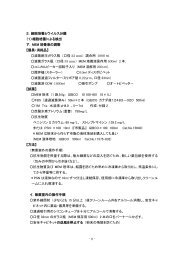Program and Abstracts(PDF)
Program and Abstracts(PDF)
Program and Abstracts(PDF)
You also want an ePaper? Increase the reach of your titles
YUMPU automatically turns print PDFs into web optimized ePapers that Google loves.
Poster presentation 17<br />
EFFECTS OF DIFFERENT SUPPLEMENTATION LEVELS OF EXTRACTED SOY<br />
PEPTIDE ON GROWTH PERFORMANCE AND TOLERANCE TO HIGH<br />
TEMPERATURE STRESS IN JUVENILE JAPANESE FLOUNDER, PARALICHTHYS<br />
OLIVACEUS<br />
Janice A. Ragaza 1* , Roger Edward Mamauag 1 , Yoshinori Sotoyama 2 , Saichiro Yokoyama 2 ,<br />
Manabu Ishikawa 2 , <strong>and</strong> Shunsuke Koshio 2<br />
1<br />
United Graduate School of Agricultural Sciences, Kagoshima University, Kagoshima 890-<br />
0056, Japan<br />
2 Laboratory of Aquatic Animal Nutrition, Faculty of Fisheries, Kagoshima University,<br />
Kagoshima 890-0056, Japan<br />
* Email: janice_a_ragaza at yahoo.com<br />
The experiment was designed to examine whether different supplementation levels of<br />
extracted soy peptide (SPEP) to soy protein concentrate (SPC) diet could improve growth<br />
performance, amino acid body composition, <strong>and</strong> tolerance to high temperature stress in<br />
juvenile Japanese flounder (Paralichthys olivaceus). Four isonitrogenous <strong>and</strong> isolipidic SPC<br />
diets <strong>and</strong> one fishmeal (FM) diet (positive control D1) were prepared with increasing SPEP<br />
supplementation levels of 0% (D2), 2% (D3), 5% (D4), <strong>and</strong> 10% (D5), respectively. Triplicate<br />
groups of twenty juveniles (1.29±0.01 g, mean ± SD) were stocked in 100-L polypropylene<br />
tanks <strong>and</strong> were fed twice a day to apparent satiation level for 42 days.<br />
The present study demonstrated that fish fed D5 grew faster than those fed diets 2, 3, <strong>and</strong> 4,<br />
respectively, although growth was significantly lower in fish fed D5 than that in fish fed D1.<br />
The feed conversion ratio <strong>and</strong> protein efficiency ratio showed the same trend as that of growth<br />
performance, but feed intake was not significantly (P > 0.05) different among diets. Except<br />
for some amino acids, whole body total <strong>and</strong> free amino acid compositions of flounder were<br />
not altered by SPEP supplementation in the diets.<br />
In the lethal heat stress test, fish fed D5 demonstrated the highest value of LT 50 , which was<br />
significantly (P < 0.05) longer than that of fish fed other diets. Furthermore, LT 50 values of<br />
fish fed diets D3 <strong>and</strong> D4 were significantly (P < 0.05) longer than fish fed D1. Heat shock<br />
protein 70 family (HSP70s) was highest in the gill, liver, <strong>and</strong> skin of fish fed D5, which was<br />
significantly (P < 0.05) higher than that of fish fed other diets after sub-lethal stress exposure.<br />
Moreover, HSP70s values of fish fed D3 <strong>and</strong> D4 were significantly (P < 0.05) higher than fish<br />
fed basal <strong>and</strong> control diets. Time-course sub-lethal heat shock exposure results demonstrated<br />
that level of HSP70s significantly (P < 0.05) decreased among all groups during recovery<br />
period, but did not return to normal <strong>and</strong> initial state after 24 hours.<br />
Based on the overall performance of the fish, SPEP can be efficiently absorbed <strong>and</strong> utilized by<br />
flounders, but more than 10% supplementation might be needed to catch up the performance<br />
of fishmeal based diet in the condition applied in this study.<br />
82



